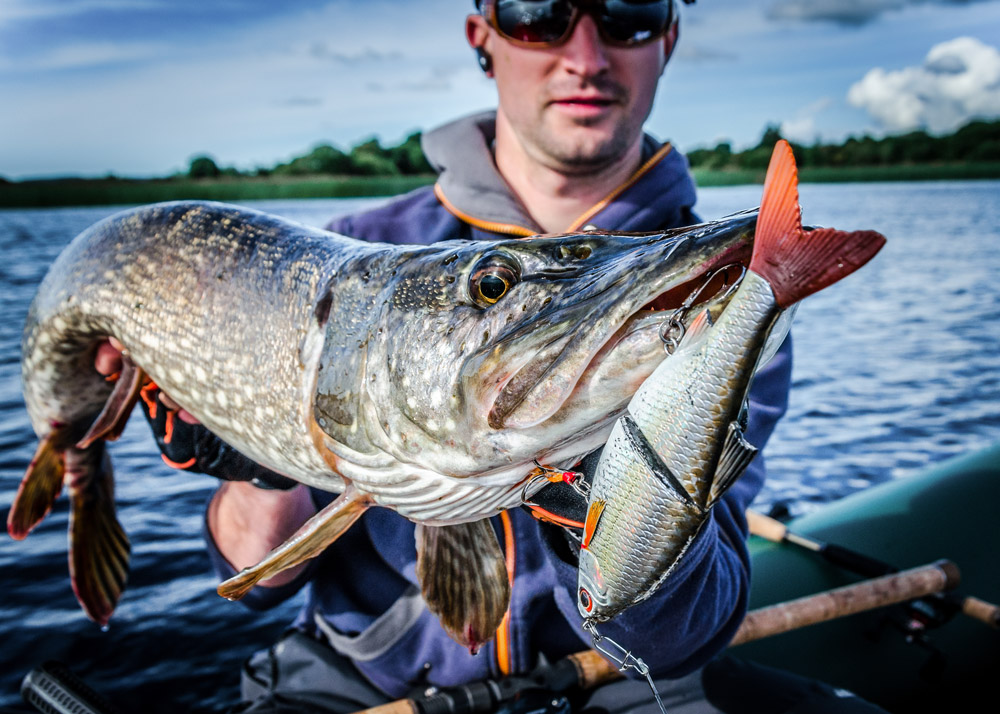
Pike fishing is one of the most widespread practices in the French fishing world. With rod and reel in hand, this species of predator fish is clearly one of the most popular, along with the pike-perch, with lure anglers and fly-fishermen alike.
Its teeth are undoubtedly the most complicated part of the lure. With 700 razor-sharp snags, ready to keep their prey in their mouths, you can't rely on nylon fishing line or braid to go the distance.
That's why you'll need to equip yourself with some very special rigs, which are easy to create using our collection of pike fishing tackle. Depending on the technique used, you can vary the line used, the size of thehook and the material, such as steel or fluorocarbon.
You need to distinguish between fishing with pike lures. Pike lure fishing requires you to make or buy stingers to directly rig your soft tackle. Depending on the type ofaction you want to do or how you want to get through the weed beds, you'll need to choose wisely.
The leader will have to alternate between resistance and discretion. This is an art that the new steels and titaniums can achieve. The season and the colour of the surface water can also have an impact, as can fishing in lakes or rivers.
All you need to do now is remember one of your elders' precious pieces of advice about never putting your fingers in a fish's mouth, and to use pliers for all handling.
The different materials available to anglers
_1.jpg)
As we saw in the introduction, pike fishing requires a minimum of preparation in the choice and construction of your rigs. This is the prerequisite for a smooth fishing trip. There are several different materials at your disposal.
Fluorocarbon is probably the most popular. It combines a number of advantages. It will be particularly discreet, even almost invisible once in the water. It is highly resistant to abrasion and is difficult to cut by fish teeth. However, it has two disadvantages. It will be difficult to tie, as you will have to start with very large diameters to avoid cutting.
Steel is still the most widely used material today. Technical advances mean that we now have materials that are both strong and flexible. They are clearly ideal for resisting cutting, but will remain difficult to knot and assemble.
More recently, manufacturers have introduced a new material: titanium. These metal wires have the advantage of being easy to fit with sleeves, but also of being very resistant to corrosion. Their strength is greater than that of steel of the same diameter. This ensures greater discretion and flexibility in animations. On the other hand, they are much more expensive and, as a result of poor quality manufacturing, sometimes have a reputation for easy breakage that is totally unfounded.
The different models
Thanks to these different materials, you can create different types of creations to protect yourself from cuts and breakage. Each technique will have its own rig preference.
To stalk pike with hard bait, opt for a 30-50cm stack. You can choose from all the models available to you, but make sure you leave plenty of room at the front attachment. Otherwise you could slow down the swim and reduce the effect of your animation.
The soft bait leaves other possibilities open to you. For jig head rigs, opt for the same type as for hard bait. But you can also create a stinger or flying hook in the same way as for vertical pike-perch fishing. Steel is still the best option, as it is designed to be used in the mouth of a predator.
You can also try a Shallow rig. Designed to rig large soft lures, this rig can be set up in a variety of ways, ensuring that you adapt perfectly to the size of your lure. Do-it-yourselfers are sure to find plenty of little variations, whether it's to unbalance a swim or pass safely through weedbeds.
Depending on the season, you may also need to do some drop shot fishing. Discretion being essential in these approaches, we would tend to focus our advice on the choice of a fluorocarbon.
Essential accessories
In order to be comfortable with your rig, you'll need to equip yourself with a number of products. This will ensure that you are not always chasing after certain elements and getting bogged down in your work.
Depending on your choices, you'll need to keep a permanent supply of small accessories. You'll need broken rings of various sizes, pins for your soft lures, screws and sleeves.
Don't forget swivels and staples. Investing in a sturdy storage box with small compartments will save you a lot of time and is a wise investment.
You'll also need to buy tools. To fit all the little accessories and to do it properly, you'll need to choose models that are perfectly adapted to your needs, and that meet specific requirements. You'll need to invest in a pair of sleeves pliers, split ring pliers or cutting pliers.
A multi-purpose model might be good for taking to the water's edge, but precise models are preferable once you're home.
Just like your rod and reel, your rig for stalking predators needs to be given every attention. Whether you're fishing on the surface, in lakes or in whitewater, it will ensure that your fishing is successful and that you get through to the end.
Our other articles about pike lures:
